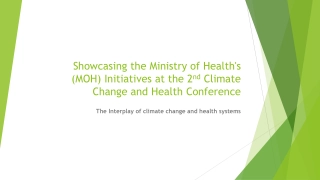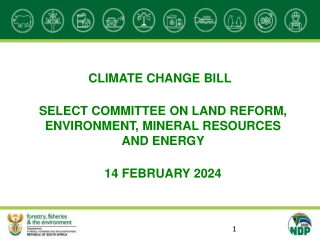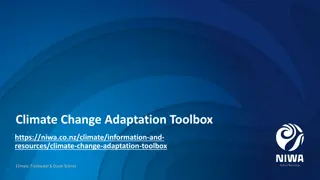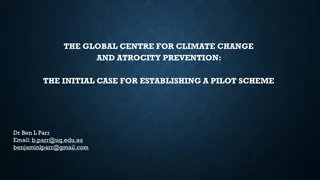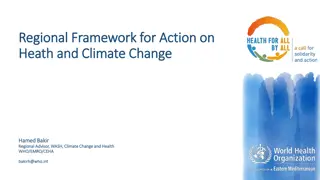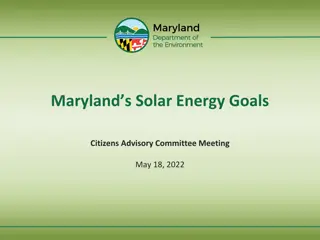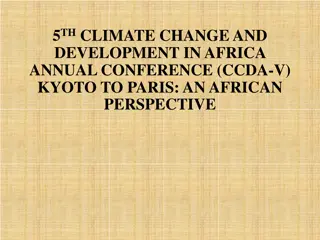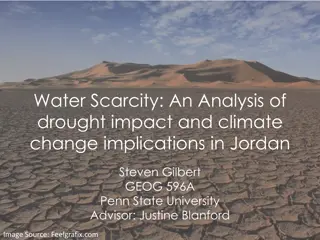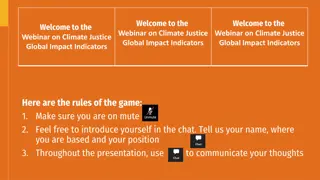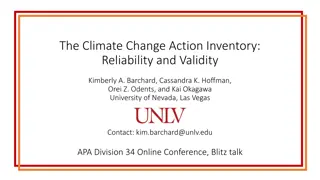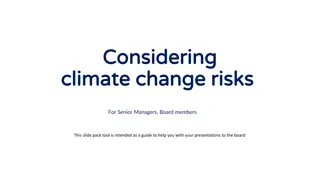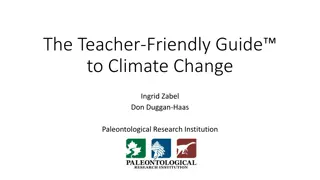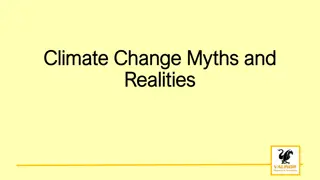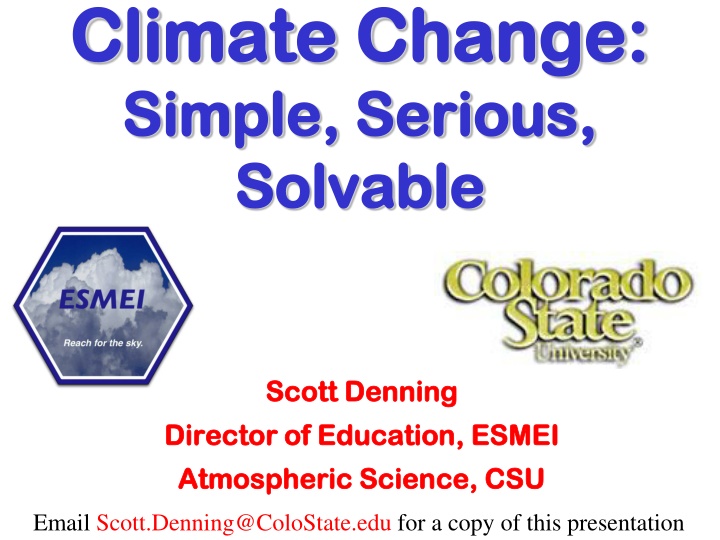
Climate Change: Simple, Serious, Solvable - Insights and Implications
Delve into the intertwined concepts of climate change, heat budgets, and the role of greenhouse molecules in absorbing and emitting infrared radiation. Understand the basics of heat transfer, molecular vibrations, and the impact of doubling CO2 levels. Explore how these factors contribute to the warming of our planet, paving the way for a discussion on actionable solutions.
Download Presentation

Please find below an Image/Link to download the presentation.
The content on the website is provided AS IS for your information and personal use only. It may not be sold, licensed, or shared on other websites without obtaining consent from the author. If you encounter any issues during the download, it is possible that the publisher has removed the file from their server.
You are allowed to download the files provided on this website for personal or commercial use, subject to the condition that they are used lawfully. All files are the property of their respective owners.
The content on the website is provided AS IS for your information and personal use only. It may not be sold, licensed, or shared on other websites without obtaining consent from the author.
E N D
Presentation Transcript
Climate Change: Climate Change: Simple, Serious, Simple, Serious, Solvable Solvable Scott Denning Scott Denning Director of Education Director of Education, , ESMEI Atmospheric Science, CSU Atmospheric Science, CSU ESMEI Email Scott.Denning@ColoState.edu for a copy of this presentation
1. 1. Simple Simple 2. Serious 2. Serious 3. Solvable 3. Solvable
1. 1. Simple Simple 2. Serious 2. Serious 3. Solvable 3. Solvable
Ever Wonder Why? Day Day is warmer than night Summer Summer is warmer than winter Phoenix Phoenix is warmer than Fargo night winter Fargo
Heat Budgets Heat Budgets Heat in Heat out Heat out Heat in
Dancing Molecules and Heat Rays! Dancing Molecules and Heat Rays! Nearly all of the air is made of oxygen (O2) and nitrogen (N2) in which two atoms of the same element share electrons O O N N Infrared (heat) energy radiated up from the surface can be absorbed by these molecules, but not very well Diatomic molecules can vibrate back and forth like balls on a spring, but the ends are identical
Dancing Molecules and Heat Rays! Dancing Molecules and Heat Rays! Carbon dioxide (CO2) and water vapor (H2O) are different! C O O O They have many more ways to vibrate and rotate, so they are very good at absorbing and emitting infrared (heat) radiation H H Molecules that have many ways to wiggle are called Greenhouse molecules Absorption spectrum of CO2 was measured by John Tyndall in 1863
Common Sense Common Sense 1 m Doubling CO2 would add 4 watts to every square meter of the Earth, 24/7/365 Doing that would make the surface warmer This was known before light bulbs were invented! 4 Watts 1 m John Tyndall, January 1863
Common Myth #1 Common Myth #1 Scientists expect a warmer future because it s been warming up recently WRONG! It s because we know that when we add heat to things, they warm up
1. 1. Simple Simple 2. Serious 2. Serious 3. 3. Solvable Solvable
Recent Changes Recent Changes APPROVED SPM Copyedit Pending IPCC WGII AR5 Summary for Policymakers More warming on land than ocean Warming since 1900 less than 1 C over ocean Warming since 1900 around 1 C over land Figure SPM.4. WGII AR5 Phase I Report Launch 38 31 March 2014
APPROVED SPM Copyedit Pending IPCC WGII AR5 Summary for Policymakers APPROVED SPM Copyedit Pending IPCC WGII AR5 Summary for Policymakers Observed Change 1901-2012 Big Big Choices Choices Figure SPM.4. WGII AR5 Phase I Report Launch 38 31 March 2014 Figure SPM.4. WGII AR5 Phase I Report Launch 38 31 March 2014
Past and Future Past and Future Difference in climate between a low-emissions (RCP 2.6) and high- emissions (RCP 8.5) don t become large until mid-century APPROVED SPM Copyedit Pending IPCC WGII AR5 Summary for Policymakers Assessment Box SPM.1 Figure 1. WGII AR5 Phase I Report Launch 39 31 March 2014
How much warmer? How much warmer? Low Emissions Land vs ocean! North vs South Global mean warming of 2 to 5 C Moderate Emissions North American warming of 3 to 6 C = 5 to 11 F = 5 to 11 F Arctic warming of 8 to 14 F High Emissions RULE OF THUMB: Global Warming (Celsius) x 1.6 (USA) x 1.8 = Fahrenheit
Where Where is it 10 on average? is it 10o o F Warmer F Warmer Seattle Sacramento Denver Amarillo Illinois Mississippi Washington DC Tallahassee 10 oF warming is like moving 600 800 miles South! Water? Real Estate? Health? Crops?
A Region A Region On On the Edge the Edge MT WA OR WY ID NV UT CO 75 million people in the western US live in a region with marginal precipitation AZ CA NM Just enough snow to support forests and reservoirs TX Just enough irrigation water to support farming Just enough water for cities and towns
Snowpack Snowpack
Declining Snowpack Declining Snowpack Colorado Statewide April 1 Snowpack for 1968-2016 160% 140% Percent of Median Snow Water Equivalent (S WE) 120% 100% 80% 60% 40% 1968 1970 1972 1974 1976 1978 1980 1982 1984 1986 1988 1990 1992 1994 1996 1998 2000 2002 2004 2006 2008 2010 2012 2014 2016 20% less snowpack over 49 years Less than 2 Fahrenheit average warming
Water Budgets Water Budgets Evaporative demand increases w/ temperature In Out Drought is the running sum of water out minus water in
Droughts Past & Future Droughts Past & Future Tree rings Tree rings Dust Bowl Medieval Megadroughts Climate Climate models models Coming droughts much much worse than any in past 1000 years
Warming Promotes Wildfire Warming Promotes Wildfire 1. Warmer air increases evaporative demand on forests 2. Longer warm season depletes soil moisture 3. More frequent extremely hot, dry, windy days when fires are uncontrollable Projected Increase in Area Burned 656% 656% NRC 2011
Storm Surge Storm Surge Frequency Frequency Big storms push a dome of water onto land Small storm surges happen a lot Big storm surges are more rare Huge surges extremely rare height above sea level (feet) 18 15 12 9 6 Coastal Flooding Rockaway Beach, NYC 3 10 100 1000 10000 How often (years)
Coastal Coastal Flooding Flooding Sea level rise Sea level rise shifts the line shifts the line up Floods of a given Floods of a given depth happen depth happen more often more often What was a What was a 100 100- -year flood year flood becomes a becomes a 10 10- -year flood! year flood! Rockaway Beach, NYC up height above sea level (feet) height above sea level (feet) 12 9 6 flooded subway system 3 10 100 1000 how often (years) how often (years)
Hurricane Hurricane Sandy Floods Sandy Floods the NYC Subway the NYC Subway 29
Billions and Billions Billions and Billions Shanghai 1991 and 2012 Shanghai 1991 and 2012 Currently 7 billion people on Earth but only 1 billion use lots of energy Rapid development to 4 billion energy users over coming decades Population growth only 30% but energy growth 300% by 2100
Like Moores Law Like Moore s Law 10 To limit warming to 2 C, emissions have to fall 50% each decade starting now! This will be really hard! Future Fossil Fuel Emissions 8 GtC/yr 6 4 2 0 Rockstrom et al (2017) A roadmap for rapid decarbonization Science 24 Mar 2017: 355, 1269-1271 DOI: 10.1126/science.aah3443 2020 2030 2040 2050
Common Myth #2 Common Myth #2 When we reduce or stop burning fossil fuel, CO2 will go away and things will go back to normal Warming (Celsius) CO2 CO2 (ppm) If China and India industrialize with coal, CO2 will rise to 4x preindustrial preindustrial warming 4x you are here Extra CO2 will last for thousands of years thousands of years after after coal is gone coal is gone emissions GtC/yr year Thermostat only turns one way!
Emissions peak soon CO2 Lasts Much Longer
Bigger than Bigger than Deglaciation Deglaciation Warming is permanent But 50x as fast
Climate and Sea Climate and Sea Level Level Linear Linear relationship relationship between climate & sea level over 40 million years
Climate and Sea Climate and Sea Level Level
Climate and Sea Climate and Sea Level Level Seas rose 1 foot per decade for 400 years
Eventually http://www.freetech4teachers.com/2013/09/an-interactive-map-of-rising-sea-levels.html
1. 1. Simple Simple 2. Serious 2. Serious 3. Solvable 3. Solvable
Efficient Architects! $4.5 TRILLION SAVINGS ! Energy to Power US Buildings 2010 2020 2030
diagram showing the generated electricity, the three trends observed previously for solar energy can be seen. But this time WEO 2002 forms a group itself. The second group spans the reports from 2004 to 2009 and the third the ones from 2010 to 2014. Despite a decrease in the full load hours in 2009, the trend is clearly upward as well as for historical data and for projections. Historic numbers show that the full load hours of wind energy are about two times higher than for solar PV, and projections assume roughly 80% higher full load hours, which is mainly driven by the fact that wind plants can harvest energy 24 hours per day and PV systems only during the daylight. companies. Most companies want to achieve usual return rates of 10-20%. Yet, investments in renewable energy often allow only 5-10% return rates, which due to a significantly lower risk profile are accepted by many investors as sufficient. However, many energy companies showed a very limited propensity to invest in renewable energy and continued investing in conventional power plants. Since the WEO projections were wrong, the companies were not warned in time. As a result, there were stranded investments in new nuclear power plants (on the side of state-influenced or state- owned enterprises, such as Flamanville in France or Olkiluoto in Finland) and many more in the fossil sector (both public and private companies), with significant economic dislocation and unnecessarily high CO2 in the past and is still in the present. This does not reflect the dynamics of the solar markets around the world. expect for the year 2030 wind energy capacities of 2908 GW (Greenpeace) [29], 1318 GW (Bloomberg) [30] and 960 GW (RE experts of the IEA) [40], which is in line with the WEO expectations. Bloomberg projects about 30% higher numbers, but the Greenpeace numbers appear unrealistically high, in particular in relation to their own projections for solar PV of 1764 GW, since the growth rates of solar PV are typically higher than those of wind energy. The relative growth ratio of solar PV and wind energy appears in line with the historic records for the projections of Bloomberg and RE experts of the IEA. Energy Agency predicts very slow penetration of renewable energy a central role in the fight against climate change, a wide civil societal discussion of the causes of the structural failure in the WEO projections is needed in order to avoid these failures in future. emissions. The leading international institutions on RE projections It is recommended to examine in another scientific study what the reasons for these false projections of the WEO in the solar sector are: systematic scientific assumption errors or additional institutional limitations. Since solar PV plays Predictions vs Reality SOLAR Year after year, the International Summing up, the WEO projections of the early 2000s had been as comparably wrong for wind energy as those for solar PV. The same linear growth assumption, instead of the real exponential growth such as that witnessed for solar PV, leads to rather low projections for the decades to come. The projections of leading international institutions do not show a consolidated picture and are partly rather close to the recent WEO projections. As far as the future WEO wind energy projections are concerned, we may assume that they will be significantly below the real growth rates. In the past, incorrect WEO projections already caused big problems for energy WIND Year after year, they re WAY wrong! Why? Fig. 5: Solar capacity (top and center), electricity generation (bottom, left) and solar full load hours (bottom, right) for the years 1999 to 2040. The historical data are given for the years 1999 to 2014 for electrical capacity, from 2000 to 2012 for electricity generation and from 2002 to 2012 for the full load hours. The projections range from 2010 to 2040. Data are based on WEO 2002 to WEO 2014 [13-23], Werner et al. [26] and REN21 [78]. 3.6 Wind As with solar energy, wind energy was published for the first time in WEO 2002, which means that the historical curve starts from 1999 (Fig. 6). Wind energy presents the same particularities as solar energy, and a similar presentation can be found. The electrical capacity figure (Fig. 6) is focused on the historical curve (top), but also on future projections (center), while the electricity production figure gives an overall view of the situation. It can be seen that WEO 2002 projections are wrong from the very beginning, since the 2030 projections had been historically achieved in the year 2010, 20 years earlier and only eight years after publishing. The key reason for the misleading projections is the assumed linear growth, i.e. no annual market growth, instead of real exponential growth, i.e. annual market growth This is quite similar to the key projection error for solar PV. Real wind capacity in 2010 is respectively higher, i.e. 260% and 104%, than WEO 2002 and 2004 projections for the same year. Historic data for the years 2013 and 2014 coming from the REN21 report [78] for wind energy do not show a deviation of the historic data to the latest projections. It can be noticed that there is an inflexion point around 2009, where the annual growth before was 24 GW (or less) and 39 GW (and more) after, mainly accelerated by installations in China. On the
Price of Solar Price of Solar PV Cells ( PV Cells ($/watt $/watt) ) Price has fallen by factor of 200 since I graduated from high school Factor of 5 since 2011 Now as cheap or cheaper than coal or gas Flatter in1990s
PV Resource: Germany vs. U.S. Solar Resources Solar Resources US vs Germany German electricity 4% wind & solar in 2000 32% wind & solar in 2016
Battery Storage Battery Storage In 2015, BNEF predicted $150/kWh by 2025 2017 Chevy Bolt Chevy Bolt reached $145 already (8 years early)! Now 7 times cheaper than in 2010! Next year: Tesla Gigafactory Bloomberg New Energy Finance Data
Costs Costs Conversion to 100% noncarbon energy will cost about 1% of GDP That s about what it cost to retrofit all the world s cities with indoor plumbing a century ago It was SO SO worth it!
My Grandparents My Grandparents
My Grandparents My Grandparents Generation Generation Built subways, sewers, the electrical grid, defeated the Nazis
My Parents My Parents
My Parents My Parents Generation Generation Built the Interstate Highways, fought the cold war, landed on the Moon!
Jennifer & Me Jennifer & Me
My Generation My Generation Invented the PC, Built the internet, replaced billions of land-lines with cell phones
My Kids My Kids
My Kids My Kids Generation Generation Will replace the world s energy system again!
Choose Your Future Choose Your Future Many people think: Our well-being is based on stuff we extract from the ground When we stop burning coal, will our descendants shiver in the dark?

